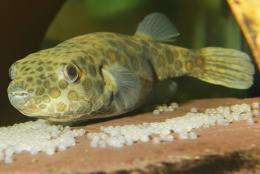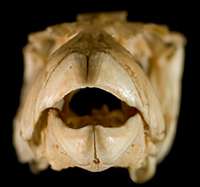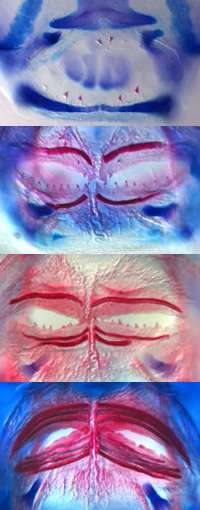How the pufferfish got its beak

The origin of the unusual beak of pufferfishes has been discovered, giving new clues about how such unique structures can evolve, scientists report today.
Pufferfishes belong to a group that includes the triggerfishes, boxfishes and ocean sunfishes. They have some of the most unusual teeth you're ever likely to see underwater.
Perhaps the most bizarre, however, is the 'beak' of pufferfishes. It's made of beak-shaped toothplates and it uses them to crush and slice prey.
But exactly how is it formed? Scientists have found the answers.
A team led by Gareth Fraser of the University of Sheffield, including Natural History Museum scientists Ralf Britz, Zerina Johanson and Andie Hall, and Moya Smith of London’s King’s College, report their findings in the journal Proceedings of the National Academy of Sciences (PNAS).
Pufferfish larvae have normal conical teeth.
The team investigated how the teeth develop and the genes responsible.
They studied pufferfish young, or larvae, which begin life with normal conical teeth, taking hundreds of snapshots of the fishes developing. They identified the different stages of tooth development, staining tooth structures red so that they could easily see the changes.
They found that the beak is formed by a strange modification of just the 4 front teeth.

Normal teeth at start
In the first stage, the individual teeth grew at exactly the same time and in the same positions as in other bony fishes.
These are called the first generation teeth and they disappear through wear.
This developmental pattern has been conserved for over 400 million years, since the last common ancestor of the pufferfish and other fish like lungfish.
Stages of tooth development (stained red) showing the change from teeth, to bands, to the beginnings of a pufferfish 'beak'.

4 front teeth
The next stage involves the 4 teeth at the front. Replacement teeth develop underneath that have a very different shape, forming bands that extend along the length of the jaw. The first band develops when the larva is around 5mm long.
More bands form underneath and make a stack that eventually replaces the first generation teeth once they are worn away. This becomes the beak structure.
Gene tinkering
The team thought this change may be due to a new gene network (a set of genes interacting in a new or undiscovered way).
In fact, this change is initiated by a small change during the normal process of tooth development, following the existing genetic blueprint or template, originating at least 400 million years ago.
The only difference is that the genes are expressed along the whole length of the jaw, rather than restricted to one small area.
"So, what seems like a major evolutionary leap turns out to be a series of tiny steps in development," says Britz, fish researcher (ichthyologist) at the Museum.
"Our study shows how evolution can produce highly modified morphological structures by just tinkering slightly with developmental programs.
"Our results are nicely summarized in the Latin sentence "Natura non facit saltus", Nature does not make jumps."
More information: PNAS paper: Replacing the first generation dentition in pufferfish with a unique beak
Journal information: Proceedings of the National Academy of Sciences
Provided by Natural History Museum

















